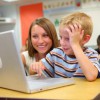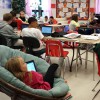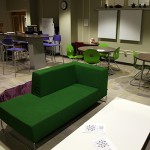 Kate Bishop, ACPS alumna and current PhD student in Anthropology at the University of California, has received the National Geographic Young Explorers Grant, a prestigious grant designed to support our world’s most promising explorers. In an article posted earlier this month by Destination Imagination (DI), Kate took the opportunity to attribute who she is as a person and an archaeologist to her DI experience. She specifically thanked our own Burley Middle School principal, Jim Asher, for being a fabulous DI team manager and “the world’s most patient, supportive man.” Kate went on to say, “As a child, I had no idea the impact Destination Imagination was having on my life. Today, I can’t imagine where I would be without it.” Read the DI blog post »
Kate Bishop, ACPS alumna and current PhD student in Anthropology at the University of California, has received the National Geographic Young Explorers Grant, a prestigious grant designed to support our world’s most promising explorers. In an article posted earlier this month by Destination Imagination (DI), Kate took the opportunity to attribute who she is as a person and an archaeologist to her DI experience. She specifically thanked our own Burley Middle School principal, Jim Asher, for being a fabulous DI team manager and “the world’s most patient, supportive man.” Kate went on to say, “As a child, I had no idea the impact Destination Imagination was having on my life. Today, I can’t imagine where I would be without it.” Read the DI blog post »
Category Archives: Article/Blog Spotlight
6 Ways to Make a Mark on Social Media
 What can students do on social media that can help them get noticed (and even accepted) by colleges? Parke Muth, former University of Virginia Associate Dean of Admissions, offers 6 Ways to Make a Mark on Social Media, aiming “to let students know how to develop some ways of communicating that will become increasingly important in the coming years.”
What can students do on social media that can help them get noticed (and even accepted) by colleges? Parke Muth, former University of Virginia Associate Dean of Admissions, offers 6 Ways to Make a Mark on Social Media, aiming “to let students know how to develop some ways of communicating that will become increasingly important in the coming years.”
What’s Going on Inside the Brain Of A Curious Child?
 “Curiosity really is one of the very intense and very basic impulses in humans. We should base education on this behavior.” ~ Dr. Evie Malaia, Assistant Professor, Southwest Center for Mind, Brain, and Education
“Curiosity really is one of the very intense and very basic impulses in humans. We should base education on this behavior.” ~ Dr. Evie Malaia, Assistant Professor, Southwest Center for Mind, Brain, and Education
“What, exactly, is curiosity and how does it work? A study published in the October issue of the journal Neuron, suggests that the brain’s chemistry changes when we become curious, helping us better learn and retain information.” Read more about “What’s Going on Inside the Brain Of A Curious Child” in MindShift.
Engaging Our Learners Through Natural Curiosity
 We educators have spent much of our time focusing on what children are expected to learn, but how they learn is often less of a focus. Babies are born with “core knowledge” that helps them process the world. When the world doesn’t function according to what babies think will happen, they become further engaged and curious to learn more (see “Why Babies Love (And Learn From) Magic Tricks” in NPR Ed). Continue reading
We educators have spent much of our time focusing on what children are expected to learn, but how they learn is often less of a focus. Babies are born with “core knowledge” that helps them process the world. When the world doesn’t function according to what babies think will happen, they become further engaged and curious to learn more (see “Why Babies Love (And Learn From) Magic Tricks” in NPR Ed). Continue reading
15 Digital Storytelling Tools for Educators
 “Engaging, multimedia-rich digital stories can capture the attention of students and increase their interest in exploring new ideas. Combining storytelling with powerful digital creates a truly authentic learning experience that helps students develop a wide range of intellectual skills.”
“Engaging, multimedia-rich digital stories can capture the attention of students and increase their interest in exploring new ideas. Combining storytelling with powerful digital creates a truly authentic learning experience that helps students develop a wide range of intellectual skills.”
Check out 15 digital storytelling tools on David James’ Social Learning blog.
Journey to the Student-Centered Makerspace
 Schools and communities across the United States and around the world are creating “maker spaces” for adults and students to design, create, build and engineer using a variety of tools. Read the story of how one teacher created an interest-driven space for students in the eSchool News article, Journey to the student-centered makerspace.
Schools and communities across the United States and around the world are creating “maker spaces” for adults and students to design, create, build and engineer using a variety of tools. Read the story of how one teacher created an interest-driven space for students in the eSchool News article, Journey to the student-centered makerspace.
How a Moveable Space Can Ignite Creativity in the Classroom
 Many of our schools and individual teachers are creating more flexible spaces for learners to work on projects and creative “make to learn” activities as well as to participate in collaborative discussions and seminars. Some Albemarle world language teachers using the Teaching Proficiency through Reading and Storytelling (TPRS) have taken desks out of their classrooms to facilitate this version of immersion learning. Often teachers take a “do it yourself” approach to modernizing their classrooms for more flexibility. This blog post from KQED describes how moveable spaces can provide greater flexibility for activities in the school environment.
Many of our schools and individual teachers are creating more flexible spaces for learners to work on projects and creative “make to learn” activities as well as to participate in collaborative discussions and seminars. Some Albemarle world language teachers using the Teaching Proficiency through Reading and Storytelling (TPRS) have taken desks out of their classrooms to facilitate this version of immersion learning. Often teachers take a “do it yourself” approach to modernizing their classrooms for more flexibility. This blog post from KQED describes how moveable spaces can provide greater flexibility for activities in the school environment.
“Explore. Play. Learn.” Blog Post: Genius Hour!
 Check out principal Mike Irani’s November 21 blog post about how Meriwether Lewis staff are building a Google “genius hour” approach to professional learning!
Check out principal Mike Irani’s November 21 blog post about how Meriwether Lewis staff are building a Google “genius hour” approach to professional learning!
